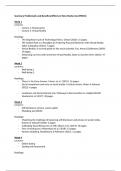Summary Problematic and Beneficial Effects of New Media Use (PBMU)
Week 1
Lectures
- Lecture 1: Moral panics
- Lecture 2: Virtual Reality
Readings
- The Sisyphean Cycle of Technology Panics, Orban (2020): 15 pages.
- The Golden Rule as a Paradigm for Fostering Prosocial Behavior with Virtual Reality,
Slater & Banakou (2021): 7 pages.
- Virtual Reality, A survival guide for the social scientist, Fox, Arena & Bailenson (2009):
19 pages.
- Enhancing our lives with immersive Virtual Reality, Slater & Sanches-Vives (2016): 47
pages.
Week 2
Lectures:
- Well-being 1
- Well-being 2
Readings:
- There Is No Easy Answer, Masur et al. (2022): 16 pages.
- Social comparison and envy on social media: A critical review, Meier & Johnson
(2022): 6 pages
- Loneliness and Social Internet Use: Pathways to Reconnection in a Digital World?
Nowland et al. (2017): 18 pages
Week 3
Lectures:
- Self-disclosure, privacy, social capital
- Phubbing and FOMO
Readings:
- Mastering the challenge of balancing self-disclosure and privacy in social media,
Kramer & Schawel (2020): 5 pages.
- Cultivating Social Resources on SNS, Ellison et al. (2014): 10 pages.
- Fear of missing out, Milyavskaya et al. (2018): 13 pages.
- Partner phubbing, Beukeboom & Pollmann (2021): 11 pages.
Week 4
Lectures:
- Online dating
- Sexting and harassment
Readings:
, - Dating apps, a literature review, Wu & Trottier (2022): 26 pages (not in summary).
- Social compensation perspective on online dating, Toma (2022): 5 pages (not in
summary).
- Sexual interaction in digital contexts and its implications for sexual health, Doering et
al. (2021), 18 pages (not in summary).
- The importance of context, Oliver et al. (2023): 18 pages (not in summary).
Week 5
Lectures:
- Cyberchondria
- Cyberloafing
Readings:
- Recent insights into cyberchondria, Starcevic et al. (2020): 8 pages.
- The IT way of loafing on the job: Cyberloafing, Lim (2002): 20 pages.
Week 6
Lectures:
- Internet pornography
- Cyberbullying
Readings:
- Curvilinear associations between pornography use and relationship satisfaction,
Willoughby et al. (2021): 10 pages.
- Cyberbullying on SNS, Chang et al. (2020): 16 pages.
Week 7:
Lectures:
- Response lecture
,Session 1: Between euphoria and moral panics
Development of new technology excessive emotional reactions, public needs to
understand it.
The Internet: A story of prophets (Negroponte, 1995) and pessimists (Carr, 2010. Problems
with cognitive capacities, lower concentration, deep reading has become a struggle).
Techlash = shift in thinking about technology:
- It describes the increasing unease about the impact that companies like Google,
Facebook and Amazon are having on everyday life.
- Widespread concern about the role of these companies is playing in fake news, social
media depression and addiction, and the polarization of
communities.
People are always skeptical when something new is developed.
Example of coffee, women wanted to ban coffee drinking, because
only men could drink this, and they would become French people.
Also skeptical about novels, movies, comic books, etc.
Media: Popular (pre/Victorian) novels
- 19th century (society thought novels were bad).
- But they are today’s school readings.
- Women could suffer overexcitement from reading, waste household time.
- Corruption of young men (emulate criminal lifestyle).
Movies:
- The devil’s camera, written in 1932 by two journalist (undermining our cognitive
strength).
- Unimaginably tragic, cinemas should be reveling in crime, idleness, etc. National
strength is being sapped.
Comic books:
- Comic books as cause of juvenile delinquency (stealing, arresting, etc.).
- Calls for censorships and U.S. congressional inquiry.
And new media. What’s next? Robots, VR, AI.
There is a pattern, moral panic, 4 core characteristics: uncertainty, public advocates,
normative, and presumably vulnerable groups.
- Uncertainty
o New behavior, no normative convention (standard) yet.
o Unknown effects.
- Public advocates
, o Judges are from establishment (politicians, parents, peers). Their judgments
can shape what others in society think.
o Self-proclaimed experts, seek reputation.
o Other groups (elites) want to protect the norms in the group. Educational
program of the elites. They don’t want to lose their power.
- Normative
o Strong moral judgments, in a moral panic, people tend to make very clear and
strong judgments about what is right and wrong.
o Fear for education, upbringing, culture. A concern that influences might
negatively impact these things.
o High (brain, classical music, modern art) vs. low (body, casual/entertaining,
kitsch art, parties) culture.
- Presumably vulnerable groups
o Children, adolescents, woman, working class. Certain groups that are seen as
vulnerable (kids, women), and they are protect worthy.
Moral panic starts with uncertainty, public advocates strive for them, we decide if it’s
normative or if something is good or bad, and then decide who we should protect and avoid
this behavior.
What is the scientific answer on moral panics? Not guided by hot emotions, but sober and
analytical look. 3 core answers (prevalence, causality, effect size):
1. Prevalence
a. How many people are involved or affected? Magnitude of the problem.
b. How often does symptom occur?
2. Causality
a. Is X really the cause of Y/consequence?
b. Media use X?
c. X media use?
d. Other factors affecting X?
3. Effect size
a. How strong is media use <> X effect?
3 stages in research, if a new medium is on the rise in society (crime & time + complex
causal analyses and theory building + cumulated evidence):
1. Crime & time – related research: is it there? How much time do people spend with
this new thing? Do people get aggressive, etc. (= crime).
a. Prevalence; how big is the problem?
b. Simple effects. (e.g., exposure effect and reporting of effect sizes). Main
effect.
c. This is often research about the negative effects of the new medium.
2. Complex causal analyses and theory-building: when and how does it work?
a. Moderation analyses; who? Risk-groups. Not just a simple effect, it depends
on who you are.
b. Mediation analyses; why? Process. Underlying reasons.
3. Cumulated evidence: can we be sure? Few years later, around 10 years later.
a. Literature reviews.





